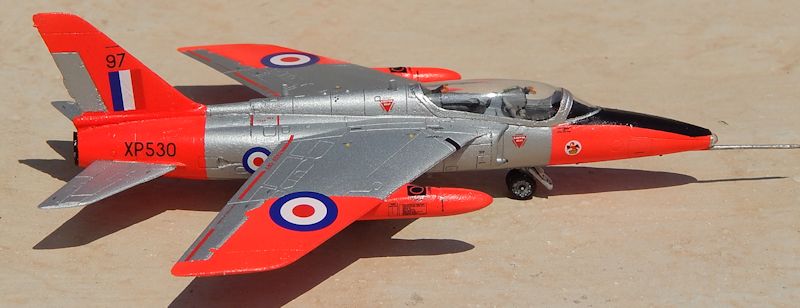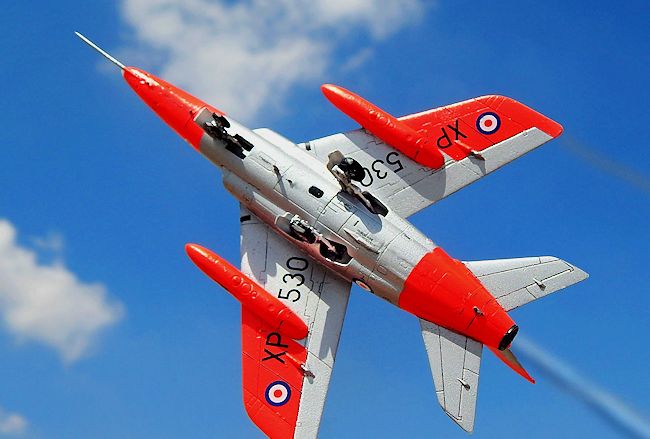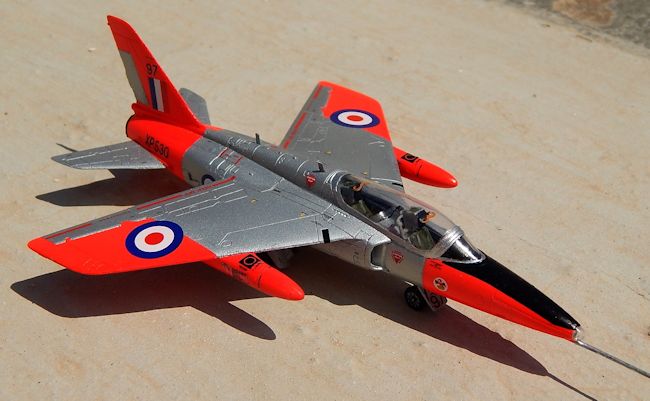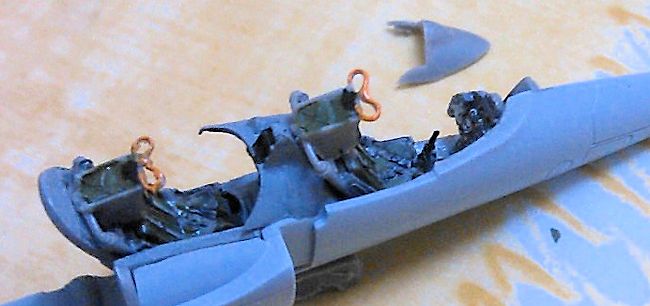
Airfix 1/72 Gnat T.1
| KIT #: | A01006 |
| PRICE: | $ |
| DECALS: | One option |
| REVIEWER: | Carmel J. Attard |
| NOTES: | New tool kit (2013) |

| HISTORY |
A ministry of supply design study contract was
awarded in the autumn 1956 and in August 1957 a batch of 14 pre-production Fo
144 Gnat trainer aircraft was awarded, the first of these flying on 31st
August 1959. It became clear however that no production orders would be placed
while Folland remained outside the major manufacturing groupings, which the
government favored, and Folland therefore merged into Hawker Siddeley aviation,
becoming its Division.
 Contracts
for 30, 20, and 41 aircraft were awarded in February 1960, July 1961 and March
1962 respectively. The last production Gnat T Mk1 flew on 9th April
1965 and was delivered to the RAF on 14th May, in the all-red scheme
of the Red Arrows.
Contracts
for 30, 20, and 41 aircraft were awarded in February 1960, July 1961 and March
1962 respectively. The last production Gnat T Mk1 flew on 9th April
1965 and was delivered to the RAF on 14th May, in the all-red scheme
of the Red Arrows.
The Central Flying School first introduced the
type in February 1962 but the major operator was No 4 Flying Training School at
Valley, UK. This took its first aircraft on strength in November 1962 and which
in 1964 introduced the Gnat to the formation aerobatic scene, operating five
all-yellow Gnats in a team known as Yellow Jacks. The team re-formed as the Red
Arrows in 1965 under the control of the Central Flying School. Its Gnats finally
withdrew at the end of 1979-display season, to be replaced in 1980 by the
British Aerospace Hawk T Mk1.
In service with the RAF the Gnat T Mk1 was the
advanced flying trainer. It proved to be fast and manoeuvrable. Its small
cockpit dimensions meant that the taller students could not be trained on the
aircraft and on these occasions the Hawker Hunter T Mk7 with its side-by-side
seating being utilized. Other users of the Gnat included the Indian Air Force,
who took the Gnat into combat, finding it to be an excellent dogfighter as well
as useful ground attack machine.
| THE KIT |
 This is not
the 1974 issue kit but a completely ‘new tooling’ kit release. It contains many
more parts than the original 34 issued in earlier, incorporating a well detailed
cockpit office comprising of crew seats, floor with back plate, embossed side
instruments, panels, control columns and two crew figures. The separate air
intake also has a side, which forms part of cockpit containing details. Released
in light gray plastic it also has lots of other much improved detail to
undercarriage area and legs, additional wing tanks besides lots of detail
externally. On top of all there is a super detailed decal sheet of very good
quality for an RAF training Gnat finished in metal and day-glow orange. There is
no flash on parts and parts fit extremely well.
This is not
the 1974 issue kit but a completely ‘new tooling’ kit release. It contains many
more parts than the original 34 issued in earlier, incorporating a well detailed
cockpit office comprising of crew seats, floor with back plate, embossed side
instruments, panels, control columns and two crew figures. The separate air
intake also has a side, which forms part of cockpit containing details. Released
in light gray plastic it also has lots of other much improved detail to
undercarriage area and legs, additional wing tanks besides lots of detail
externally. On top of all there is a super detailed decal sheet of very good
quality for an RAF training Gnat finished in metal and day-glow orange. There is
no flash on parts and parts fit extremely well.
The wheels can be assembled in the open or
closed position and instructions include color detail of interior. The decals
cater for one Gnat XP530 of Central Flying School based at Little Rassington,
Gloucestershire, UK 1964.
 In line
with the timing release of the kit, Pavla Models released a resin detail set
specifically for the ‘new tooling’ Airfix kit. This consist of a complete
cockpit detail set and I was amazed that even though the Airfix interior was
well detailed, yet Pavla went a further step by providing super detailed
ejection seats complete with seat belts, ejection handles, embossed instrument
panels and other side control panels intended to take place of the Airfix
offering. There is also a transparent windshield that fits on the mid instrument
panel and detailed control columns.
In line
with the timing release of the kit, Pavla Models released a resin detail set
specifically for the ‘new tooling’ Airfix kit. This consist of a complete
cockpit detail set and I was amazed that even though the Airfix interior was
well detailed, yet Pavla went a further step by providing super detailed
ejection seats complete with seat belts, ejection handles, embossed instrument
panels and other side control panels intended to take place of the Airfix
offering. There is also a transparent windshield that fits on the mid instrument
panel and detailed control columns.
| CONSTRUCTION |
 carefully
removed. Side panels in the Airfix kit were scraped off along with the front
coaming. The components were painted to Pavla instructions, fitted and a
quantity of lead weight added to nose space to prevent model from tail sitting.
The rest of assembly went on smooth.
carefully
removed. Side panels in the Airfix kit were scraped off along with the front
coaming. The components were painted to Pavla instructions, fitted and a
quantity of lead weight added to nose space to prevent model from tail sitting.
The rest of assembly went on smooth.
| CONCLUSIONS |
| REFERENCES |
September 2014
If you would like your product reviewed fairly and fairly quickly, please contact the editor or see other details in the Note to Contributors.